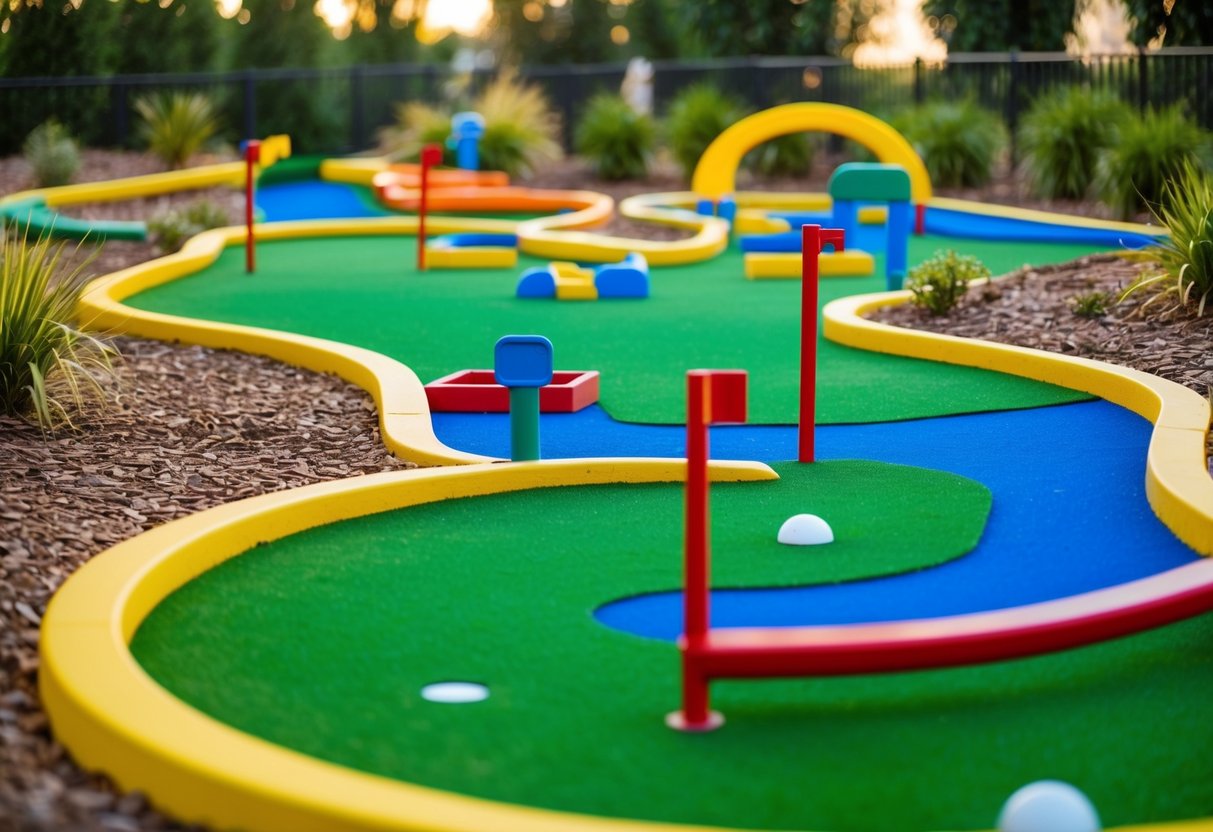Check out our golf rangefinders by Vovex to elevate your game!
Mini golf is a beloved pastime that combines skill, strategy, and fun for all ages. Whether you're looking for a casual outing with friends or aiming to improve your putting game, mini golf offers an enjoyable experience for everyone. We'll guide you through the basics of playing mini golf, from choosing the right putter to navigating tricky obstacles on the course.
Get ready to embark on a miniature golfing adventure! As we explore the ins and outs of this entertaining sport, you'll discover tips and tricks to enhance your gameplay. We'll cover everything from proper stance and grip to reading the unique terrain of each hole. By the end of this guide, you'll be well-equipped to tackle even the most challenging mini golf courses with confidence and excitement.
Key Takeaways
- Choose the right putter and maintain a balanced stance for accurate shots
- Read the course layout and adjust your strategy for each unique hole
- Practice proper etiquette and have fun while improving your mini golf skills
The Basics of Mini Golf
Mini golf offers a fun twist on traditional golf, with unique equipment and layouts. Let's explore the key differences and what you'll need to play.
Mini Golf vs. Regular Golf
We find mini golf courses are much smaller than regular golf courses. They typically feature 18 holes, each with creative obstacles like windmills or loops. The goal is to hit the ball into the hole using as few strokes as possible.
Mini golf holes are shorter, usually 10-40 feet long. We play on artificial turf instead of grass. The focus is on precision putting rather than driving or using various clubs.
Scoring in mini golf is simpler. We count strokes for each hole, with a typical par of 2 or 3. Most courses have a maximum stroke limit per hole, often 6.
Equipment Needed
To play mini golf, we need minimal equipment:
- Putter: A specialized golf club for short, precise shots
- Golf ball: Typically provided by the course
- Scorecard and pencil: To track strokes for each hole
Some courses offer different putter sizes for adults and children. We recommend wearing comfortable shoes and clothes that allow easy movement.
Optional items include:
- Sunglasses
- Hat or visor
- Sunscreen
- Water bottle
Most mini golf facilities provide all necessary equipment, so we don't need to bring our own unless we prefer to use personal putters.
Getting Started
Mini golf is a fun and accessible sport that anyone can enjoy. We'll cover the essential first steps to get you on the course and ready to play.
Choosing the Right Putter
Selecting a suitable putter is crucial for your mini golf success. Most courses provide putters, but you can bring your own if preferred. We recommend trying different lengths to find what feels comfortable. Grip the putter with your dominant hand on top and your other hand below for stability.
For beginners, a standard-length putter works well. As you improve, you might opt for a shorter putter for better control. The putter's head should be flat and have a clean striking surface.
Weight is another factor to consider. Heavier putters offer more stability, while lighter ones allow for greater feel and touch.
Understanding Mini Golf Rules
Mini golf rules are straightforward, making it easy for players of all ages to join in. Each player takes turns putting their ball from the starting point of each hole. The goal is to get the ball into the hole in as few strokes as possible.
If your ball goes out of bounds, add a penalty stroke and place it back where it was last played. Some courses have specific rules for obstacles or water hazards, so check with the staff before starting.
Keep score by counting the number of strokes for each hole. Most courses have a maximum stroke limit per hole, usually 6 or 7. If you reach this limit, move on to the next hole.
Remember to be courteous to other players and have fun!
Techniques and Skills
Mastering mini golf requires a combination of finesse, strategy, and practice. We'll explore key techniques to elevate your game on the course.
Mastering the Putting Stroke
A smooth, consistent putting stroke is crucial for mini golf success. We start by gripping the putter lightly, with our hands working as one unit. Our stance should be comfortable, with feet shoulder-width apart and eyes directly over the ball.
The stroke itself is a pendulum motion, pivoting from the shoulders rather than the wrists. We keep our lower body still and focus on a smooth backswing and follow-through. Practice maintaining a steady tempo - back and through at the same speed.
To improve accuracy, we use alignment aids on the putter or create our own by drawing a line on the ball. This helps us visualize the intended path and ensures we're striking the ball squarely.
Reading the Green
Reading the green is an art form in mini golf. We start by surveying the entire hole, noting any slopes, bumps, or obstacles. Paying attention to the grain of the artificial turf can reveal subtle breaks.
We look for the fall line - the direction water would flow if poured on the green. This indicates the primary slope. For longer putts, we break them down into segments, considering how each section will influence the ball's path.
Testing the speed of the green is crucial. We can do this by gently rolling a ball on a flat section to gauge how fast it travels. This helps us determine the strength needed for our putts.
The Art of Aiming
Aiming in mini golf often involves using banks and obstacles to our advantage. We visualize the ideal path to the hole, considering any ricochets or curves needed.
For direct shots, we use intermediate targets - a spot on the ground between our ball and the hole. This helps us align our putts more accurately, especially on longer attempts.
When facing obstacles, we consider alternative routes. Sometimes, a bank shot off a side wall can be more reliable than trying to navigate through a narrow opening.
Practice visualizing lines and angles. This skill improves with experience, allowing us to quickly assess the best approach for each unique hole layout.
Strength and Precision Control
Controlling the strength of our putts is vital in mini golf. We practice putting with different levels of force to understand how the ball reacts on various surfaces and slopes.
For uphill putts, we add a bit more power to ensure the ball reaches the hole. Downhill putts require a gentler touch to prevent overshooting. We focus on accelerating through the ball rather than decelerating, which can cause inconsistency.
Precision is key for navigating obstacles. We practice hitting the ball with just enough force to clear ramps or loop-de-loops without losing control. For tight turns, a softer hit allows the ball to curve naturally with the course design.
Navigating Obstacles
Mini golf courses are filled with various challenges designed to test our skills and strategy. Let's explore the different obstacles we'll encounter and how to overcome them.
Types of Obstacles
Windmills are classic mini golf obstacles that require precise timing. We'll need to hit our ball through the spinning blades at just the right moment. Ramps and hills add vertical challenges, testing our ability to control ball speed and direction.
Water hazards, like small ponds or streams, can be tricky. We'll have to judge the right amount of force to clear them without overshooting. Sand traps might slow our ball down, so we'll need to adjust our stroke accordingly.
Some courses feature moving obstacles like rotating platforms or swinging pendulums. These require careful observation and timing to navigate successfully.
Strategies for Overcoming Obstacles
When facing windmills or moving obstacles, patience is key. We should take a moment to observe the obstacle's pattern before taking our shot. It's often best to aim for the center of the opening to maximize our chances.
For ramps and hills, we need to consider both the upward slope and the potential speed on the way down. A gentle tap uphill can lead to a perfect position, while too much power might send us flying past the hole.
Water hazards require confidence. We should aim to clear them completely rather than trying to land just on the edge. With sand traps, a slightly firmer stroke can help our ball push through the sand more effectively.
Practice and observation are our best tools. We should watch how others tackle tricky obstacles and learn from their successes and mistakes.
Course Etiquette
Mini golf is more enjoyable when everyone follows proper etiquette. We'll cover the key aspects of playing order, respecting others, and maintaining a good pace.
Playing Order
We always start with the player furthest from the hole. This usually means the person who scored highest on the previous hole goes first. After the first stroke, the player farthest from the hole continues.
If there's a tie, we can quickly decide who goes next to keep things moving. Some groups prefer to use a consistent order throughout the game. We can agree on this before starting.
Remember, it's okay to be flexible. If someone's ready to go and it won't affect others, letting them play out of turn can speed up the game.
Respecting Other Players
We show respect by being quiet when others are putting. Avoid sudden movements or distractions in their line of sight. It's courteous to stand still and give them space.
We never walk on someone else's putting line. This can damage the turf or leave footprints that affect the ball's path. We always walk around, even if it takes a few extra steps.
Patience is key. We wait for the group ahead to finish the hole and move on before we start playing. This prevents accidents and keeps everyone safe.
Maintaining Pace of Play
We aim to keep the game moving without rushing. Be ready when it's your turn. While waiting, we can plan our shot or read the green.
If we're struggling on a hole, it's okay to pick up after six strokes. This helps prevent holdups. We can mark it as a six on the scorecard and move on.
When we finish a hole, we promptly move to the next tee. We avoid lingering to chat or celebrate, as this can slow down groups behind us.
If a faster group catches up, we offer to let them play through. It's a simple gesture that makes the experience better for everyone on the course.
Improving Your Game
Mastering mini golf requires dedicated practice and keen observation. We'll explore effective techniques, learning strategies, and course variations to elevate your skills.
Practice Techniques
Repetition is key to improving your mini golf game. We recommend setting up a practice area at home with a putting mat and obstacles. Focus on your stance, grip, and swing mechanics.
Try different club angles to understand how they affect ball trajectory. Practice reading slopes by placing a book under one side of your mat.
Create challenging scenarios by arranging household items as obstacles. This helps develop creative shot-making skills for real course situations.
Learning from Each Round
Keep a mini golf journal to track your performance. Note which holes give you trouble and why. Analyze your mistakes and successes after each round.
Pay attention to how other players approach difficult holes. Don't be shy about asking for tips from more experienced mini golfers.
Try playing the same course multiple times, experimenting with different strategies each round. This helps you discover the most effective approaches for each hole.
Mini Golf Course Varieties
Explore various mini golf course types to broaden your skills. Indoor courses often feature unique themes and complex obstacles. Outdoor courses may incorporate natural elements like slopes and water hazards.
Adventure golf courses combine mini golf with larger obstacles and storytelling elements. These challenge your ability to adapt to unexpected situations.
Glow-in-the-dark courses offer a fun twist, testing your ability to judge distances and angles in low-light conditions. Each course type hones different aspects of your game, making you a more well-rounded player.
Fun With Mini Golf
Mini golf offers endless opportunities for entertainment and friendly competition. The game's accessible nature makes it perfect for players of all ages and skill levels to enjoy together.
Playing Mini Golf as a Group
We love organizing group outings to the mini golf course. It's a fantastic way to bond with friends, family, or coworkers. To keep things interesting, we often split into teams and tally up our scores. This adds a fun competitive element without taking things too seriously.
For larger groups, we've found it works well to stagger start times every 10-15 minutes. This prevents bottlenecks and keeps the game flowing smoothly. We also like to mix up the groupings throughout the course, giving everyone a chance to chat and play together.
Don't forget to bring along a few extras like snacks, drinks, and maybe even some small prizes for the winners. It all adds to the festive atmosphere and makes for a memorable outing.
Creating Your Own Mini Golf Challenges
We've discovered that inventing our own challenges can breathe new life into familiar courses. One of our favorites is the "worst ball" game, where everyone plays from the spot of the poorest shot on each hole. It's surprisingly tricky and levels the playing field nicely.
Another fun twist is playing the entire course with just one club. We take turns choosing which club everyone must use, leading to some creative problem-solving on tricky holes.
For a real test of skill, we sometimes play "speed golf," timing our rounds and adding penalty seconds for each stroke. It's a rush trying to balance accuracy with speed!
These custom challenges keep things fresh and push us to improve different aspects of our game.
Hosting a Mini Golf Event
We've found that mini golf makes for fantastic events, from birthday parties to corporate team-building exercises. When planning, we start by reserving the course well in advance, especially for larger groups.
Decorations can really set the mood. We like to use colorful balloons, streamers, and even themed props around the course. For kids' parties, goodie bags with small golf-related items are always a hit.
To keep everyone engaged, we often organize a tournament-style competition with brackets and prizes. We make sure to have a mix of serious and silly awards, like "Most Creative Shot" or "Best Recovery from a Bad Putt."
Catering is important too. We typically arrange for finger foods and refreshments to be available throughout the event. It keeps energy levels up and adds to the social atmosphere.
Frequently Asked Questions
Mini golf is a fun and accessible sport with some unique aspects. Let's cover the most common questions people have about playing this enjoyable game.
What are the basic rules for playing mini golf?
Each player takes turns hitting their ball through the course. We aim to complete each hole in as few strokes as possible. If our ball goes out of bounds, we add a penalty stroke and place it back in bounds. The player with the lowest total score at the end wins.
Can you explain how to play mini golf for beginners?
We start by choosing a putter and ball at the course. We then take turns hitting our ball from the tee area towards the hole. We continue putting until the ball goes in. We move to the next hole and repeat until we've completed all 18 holes.
What should kids know about playing mini golf?
Kids should hold the putter with both hands and stand sideways to the ball. We encourage them to take their time and focus on gentle, controlled swings. It's important to have fun and not worry too much about the score.
How do you keep score in mini golf?
We write down the number of strokes it takes to get the ball in the hole for each player. At the end of the course, we add up all the strokes. The player with the lowest total wins the game.
What does 'par' mean in the context of mini golf?
Par is the number of strokes an average player should take to complete a hole. In mini golf, most holes have a par of 2 or 3. We try to complete the hole in par or fewer strokes for a good score.
Could you outline mini golf etiquette when playing in a group?
We should be patient and wait our turn. It's polite to stay quiet when others are putting. We move to the next hole promptly after finishing to keep the game flowing. We also avoid stepping on the putting surfaces to maintain the course.





